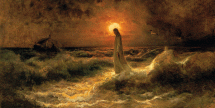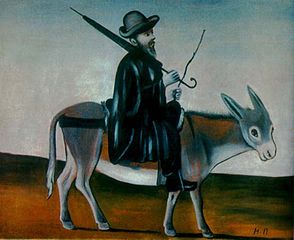The Man on a Donkey

Christ Walking on the Waters by Sergius von Klever
By H. F. M. Prescott (1952)
David Foster Wallace started his speech “This is Water” with that old but salutary saw,“There are these two young fish swimming along and they happen to meet an older fish swimming the other way, who nods at them and says, ‘Morning, boys. How’s the water?” And the two young fish swim on for a bit, and then eventually one of them looks over at the other and goes, ‘What the hell is water?'”
In 16th century Britain and Europe, the Christian religion was like water to fish. To doubt the existence of God would be equivalent to doubting gravity today. And that religiosity is the medium of Prescott’s 1952 novel, The Man on a Donkey, now reprinted in a handsome Apollo paperback. Although faith was as air in Henry VIII’s England, belief in niceties of dogma were disputed unto death, and so they are in this 716 page epic which mixes fact with fiction and historical figures with imagined, at the time of Henry’s break with Rome and dissolution of the monasteries.
The fictional heretic priest Gib Dawe swings restlessly between dark consciousness of his own mortal sin and righteous indignation at the doctrinal errors of others which are, to him, as damning. He moves restlessly back and forth across England, preaching his version of the new faith to the unsaved and fleeing the consequence of his fall from grace – his afflicted son, Wat. He has spirituality but he lacks faith. “For now he knew that though God might save every other man, Gib Dawe He could not save. Once he had seen his sin as a thing that clung close as his shadow clung to his heels; now he knew that it was the very stuff of his soul. Never could he, a leaking bucket not to be mended, retain God’s saving Grace, however freely outpoured. Never could he, that heavy lump of sin, do any other than sink, and sink again, however often Christ, walking on the waves, should stretch His hand to lift and bring him safe. He did not know that though the bucket be leaky it matters not at all when it is deep in the deep sea, and the water both without it and within.”
Robert Aske, Leader of the Pilgrimage of Grace, an uprising against Henry’s ecclesiastical reforms, swings too in the end, dying a hideous death, suspended in chains high above the ground. This is not a spoiler – Aske was a historical figure. Having one eye he was half-blind, but Prescott’s fictional Julian Savage is totally blind when it comes to her love for Robert Aske. Her childish adoration of him is charmingly captured –
“‘Do they call you Robert?’
‘Sundays and Saints Days,’ he told her, ‘but working days it’s Robin’.
”Silly!’ she cried delightedly, loving him very much, and having quite forgotten her awe of him. She began to laugh and dabbed her nose against his, and put her arms round his neck meaning to kiss him.”
– and never relents. It’s a blind reverence in the face of the one thing Julian knows – that the worst will happen someday, a belief which she quite reasonably holds in light of her early years and her position as the younger sister of the nasty Margaret (Margaret was a real person, but perhaps not really the illegitimate daughter of the Duke of Buckingham). The one almost happy period of Julian’s life is spent at Marrick Priory, but of course, that has to end. Prescott has fictionalised the life of the real Christabel Cowper, the Prioress of Marrick Priory (it will be helpful to the reader to look at the plan of the Priory at the back of the book) which Henry ultimately dissolved. Christabel is another shrewd, ambitious woman, who has an eye for luxury. Under her stewardship, the Priory thrives and the nuns live much more comfortably, they are sure, than the White Nuns, St Bernard’s Ladies, of the inferior priory across the River Swale.
Prescott’s Henry is a sadistic liar, gross and golden. “Inside the Privy Chamber the King stood before the fire; he wore velvet the colour of flame, his feet were set wide apart, his head was bent and his chin sank into roll upon roll of bristled fat above the gold-stitched collar. His bulk, blocking out the firelight on that darkly overcast forenoon seemed enormous”. He outlives three of this wives in the timespan of this tale, each of them dying off stage, two leaving daughters whom he treats with scant regard. Cromwell is the real villain of the piece, but seen as an eminence grise, distant, glimpsed occasionally and all the scarier for it.
The Man on a Donkey is an excellent historical novel, imbued with the sense of the time and of our predecessors’ earthier lives. It is psychologically adept, although the motives of some historical characters – notably Lords Darcy, Suffolk and Norfolk – remain unclear to us. The second half of the story can be perplexing to those not already familiar with the history of Henry’s reign. The various factional uprisings, the religious schisms and fickle treacheries are not easy to follow. It does not help that it seems that every man is called Robert, Ned, Will or Wat and every woman Julian, Nan, Anne, Meg or Bess. But Prescott’s prose is lucid as the water of the Swale, and captures the enigmatic quality of these events which are now so strange to us. The mundaneity of life is there – and the mystic – the latter often via the agency of the mad serving-woman Malle, whose gnomic utterances shadow Aske’s fortunes against the light of her visons of Jesus and his presence. “He that though winds, waters and stars, had made of Himself a dying man. But at last, as if it were a great head of water that had poured itself with noise, and splashing, and white foam leaping into a pool, and now; rising higher, covered its own inflow, and so ran silent, tough no less strong – now they were lifted up and borne lightly as a fisherman’s floats, and as stilly.”
Leave a comment...
While your email address is required to post a comment, it will NOT be published.



0 Comments